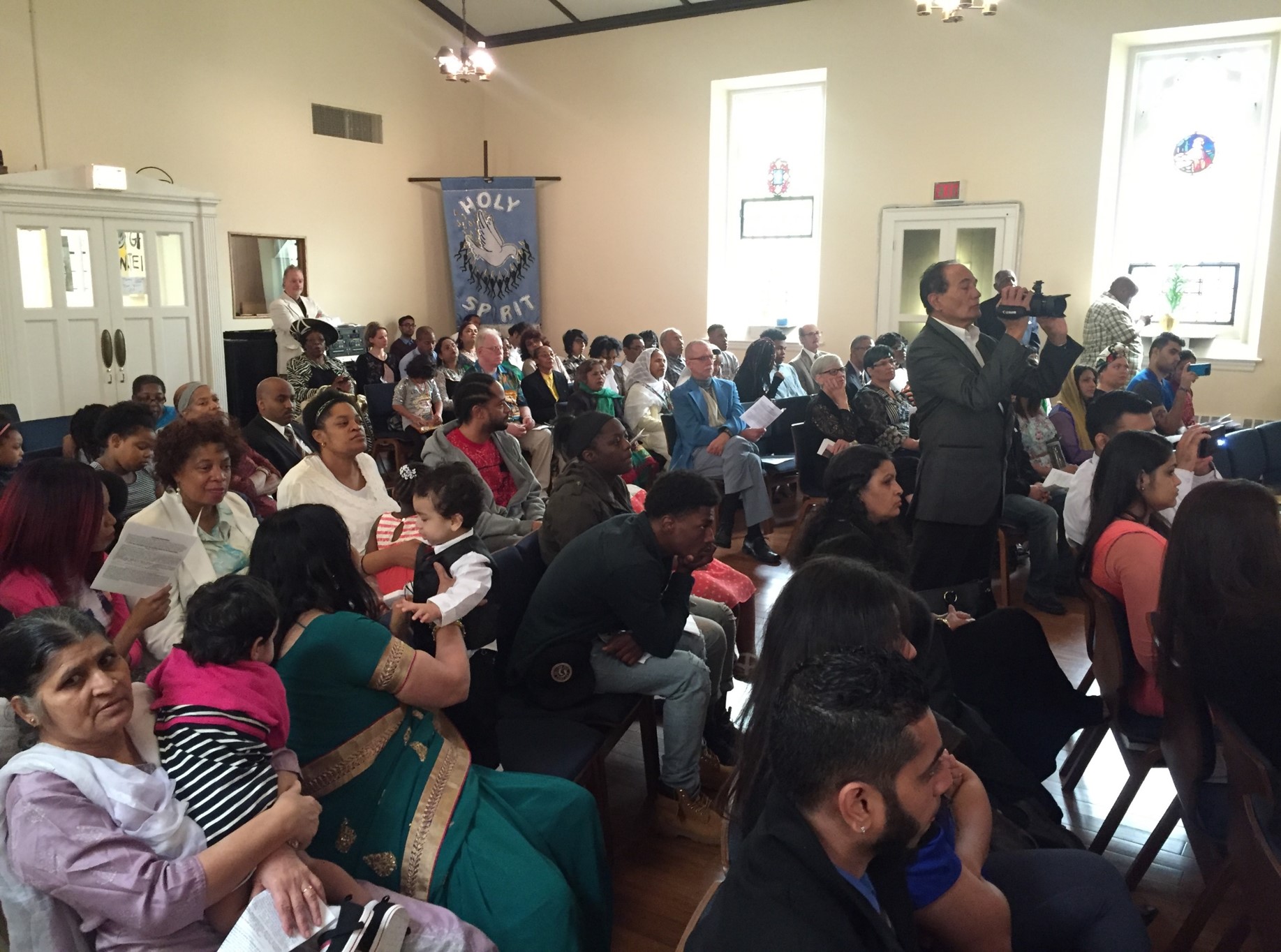As in many older urban churches, membership peaked 70 years ago for Granville Avenue United Methodist Church (UMC) in Chicago, Illinois. Meanwhile, more and more immigrant congregations seek space to meet. Granville Ave UMC—smaller although still vibrant—has responded by sharing its building with Gujarati and Eritrean congregations.
Dasia Skinner directed a Calvin Institute of Christian Worship Vital Worship Grant project to encourage regular-scheduled combined worship among the three congregations. Here she and two pastors address seven common challenges to promoting worship and fellowship among ethnically or theologically diverse congregations.
Time
Varied worship service times and individuals’ lack of free time make it hard to plan and carry out joint worship and fellowship.
The Gujarati Methodist congregation meets at 9 a.m., and the American Methodist congregation meets at 11 a.m. People don’t start gathering till 4 p.m. for Maranatha Eritrean Christian Fellowship (aka Maranatha Church Chicago), because many members are taxi drivers who work overnight or on Sunday mornings. Maranatha is part of an Eritrean church network that holds frequent events. These dynamics prevent some Eritreans from attending combined worship at 11 a.m. So far, the congregations haven’t tried scheduling combined worship on Sunday afternoons or evenings.
Relatively few smaller or immigrant congregations have the luxury of fulltime pastors and worship leaders. Most church staff members are bi-vocational or serve the church without pay. They need tremendous commitment and time management to add joint worship planning to already full church schedules.
Allen Barbour works (more than) full time as a supplier quality engineer and quarter-time as senior pastor at Granville Ave UMC. Johnson “Johnny” Christian, pastor of Gujarati Fellowship New Faith Community (UMC), is a senior network engineer. “As you may know, the IT industry is 24/7,” he says.
Dasia Skinner works as a youth and education organizer for Chicago Coalition for the Homeless and has her own digital marketing business. While directing the grant project, she also served as music department chair and worship leader at Granville Ave UMC.
Distance
Newer immigrant congregations often gather based on affinity, not proximity. They hold church services wherever they can find affordable space. Many Gujarati members drive in from northern and western suburbs. Although Granville began as a neighborhood-based church in 1905, many of its current members don’t live nearby. One reason may be that gentrification in nearby neighborhoods is raising rents in the church’s Edgewater neighborhood.
One of the first grant events was “Walk in Their Shoes,” in which native English speakers signed up to attend a Gujarati or Eritrean service. “Arriving on time was a challenge for those of us attending the 9 a.m. Gujarati Fellowship service. I drive at least an hour to get to church, and so do other families,” Barbour says.
Language

Skinner describes the Granville congregation as an intergenerational church of African American, biracial, and white members, mostly working class. They all speak English.
Gujarati Fellowship worships in Gujarati. Most of its white collar and younger members speak English, but many older Gujarati women do not. Maranatha worships bilingually in Tigrigna and English. Their children’s choir sings in English, and leaders switch back and forth between languages.
“We want to make sure that Gujarati and Eritrean members have opportunities to participate in combined worship in many ways, including community prayer, Holy Communion, and scripture reading in multiple languages,” Barbour says.
Skinner says, “It takes lots of collaboration to plan events, select speakers, plan the order of service, lead scripture, prayer, or song in different languages for our combined services. Often someone leads part of the liturgy in their language, and it’s translated for others. You have to stay on top of communication—checking in with each other weekly or more often. You have to call to make sure team members completed their tasks. If they haven’t, then you need to change roles.”
Keeping the congregation updated on grant progress made people feel excited and part of something big. Frequent communication prompted more people to help with multicultural worship.
Name discomfort
Granville services follow a structured order. They have a choir, and worshipers sing congregational songs led by piano and drums. Some members reported feeling lost and uncomfortable while attending Gujarati and Eritrean worship services. They didn’t understand the language and often didn’t know what was going on.
“Attending those services was a great learning experience and pushed our members out of their comfort zone. It brought momentum to making our services more culturally inclusive,” Skinner says.
Gujarati Fellowship services include traditional song forms and folk instruments. They and the Eritreans move more freely in response to worship than the Americans were used to. Some Gujaratis felt hesitant about worshiping with other cultures. “They wondered how to participate in Eritrean or American worship. They asked, ‘Will those people understand the way we worship?’” Christian recalls.
“The only way to outgrow shyness about worshiping in front of other cultures is to just start worshiping the Lord. Don’t worry about others. People are more accepting than you think, and they all want to learn how other cultures worship the Lord. We can all learn from each other,” he adds.
Embrace discomfort
|
“Often times churches want to invite people to join their worship—but unconsciously they really want them to conform to their way of worship.” |
The grant project addressed discomfort through events, discussions, book clubs, and a guest speaker. They did a fun, interactive workshop on building relationships. Skinner says the congregations worked to promote a spirit of inclusion, consider others more important than themselves, and trust that doing small things can make a difference.
“Reading Building a Healthy Multi-Ethnic Church by Mark Deymaz helped us understand that often times churches want to invite people to join their worship—but unconsciously they really want them to conform to their way of worship. Therefore, we learned we need to be careful not to do this,” Skinner says.
Guest speaker Mark Charles often talks about embracing the discomfort of diversity, and he spoke at Granville during the grant year. “Genese Winfrey [another grant project team member] and I went to a Calvin Institute of Christian Worship event where we heard Mark Charles preach about how we should feel uncomfortable as sinners worshiping before a holy, almighty God. Discussing discomfort taught us a hard lesson in that not every member wants to participate or be involved in multicultural worship.
“But we had enough willing participants who resonated with Revelation 7:9: ‘After this I beheld, and, lo, a great multitude, which no man could number, of all nations, and kindreds, and people, and tongues, stood before the throne, and before the Lamb, clothed with white robes, and palms in their hands.’ This is what it looks like in heaven, and this is what it is starting to look like at Granville because of this grant project,” Skinner says.
Focus on what unites you
The American Methodists took a cue from the Gujarati Methodists, who usually have a meal together after worship. Grant leaders planned fellowship meals after each combined worship service. People drew table numbers from a bag to ensure that tables had a mix of cultures. The meals often included suggestion conversation starters or games.
“These allowed members to better understand that, although we have cultural, traditional, personal, and other differences, we still serve the same God. This came through especially strong when we invited people to talk about when they became saved and how it has affected their lives,” Barbour says.
This question drew passionate responses: “How is worshipping together with people different from you pleasing to God?” Skinner recalls, “One member from the Gujarati service stood up and gave a fervent speech about unity in the body of Christ. Another member from our congregation stood up and echoed something similar. Their responses affirmed in us that though culturally different, we have a commonality, which is Jesus Christ. And through a common vehicle, worship, we are one voice and one body of Christ.”
Keep going
Christian says his congregation has been blessed by experiencing worship through different languages, musical styles, and worship practices. “It’s culturally fascinating,” he says.
Barbour adds, “I'm sure that each group is more comfortable within their own cultural identities and experiences. But for them to be open to new worship experiences outside of their comfort zone says a lot about our congregations wanting a greater relationship with God. This comes through fellowship with one another and God will get the glory.
“The main advice I can provide is to not get discouraged if everyone is not on board right away. There will be resistance. But, once a decision is made to worship jointly, allow God to touch hearts and lead the way. At the end of the day, it should be all about him.”
The grant project had a lasting effect. The Gujarati and American congregations worship together monthly. The Eritreans join in about twice a year. People are exploring ways to build relationships outside of worship services with older Gujarati women who speak less English. They’re dreaming about writing songs where people can simultaneously sing in English or Gujarati.
“Now it’s expected that worshiping with other cultures is a way to grow in fellowship, faith, and worship. Everyone expects to see Gujarati members involved in the service. They expect to see lyrics translated to English and Gujarati. They expect to hear different languages and styles of music. They expect to play cultural Indian drums, as well as the traditional piano. This impact is beautiful because it’s more welcoming, respectable, and comfortable,” Skinner says.
LEARN MORE
Read From Times Square to Timbuktu: The Post-Christian West Meets the Non-Western Church by Wesley Granberg-Michaelson. Read about the benefits and challenges of sharing church property with other congregations.

